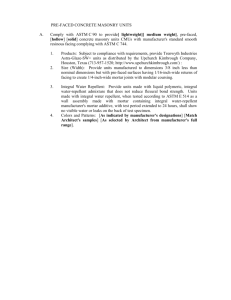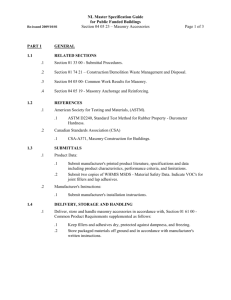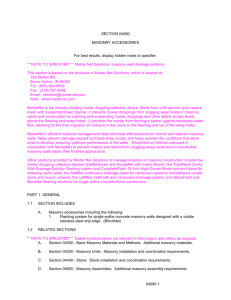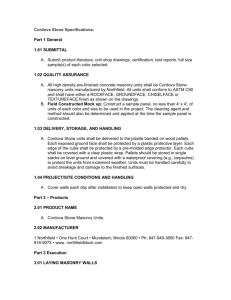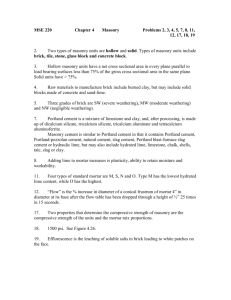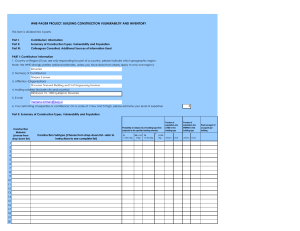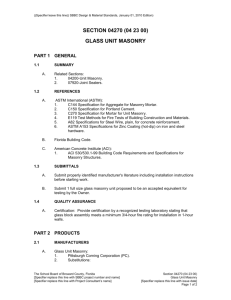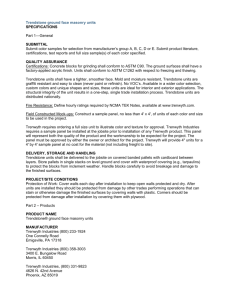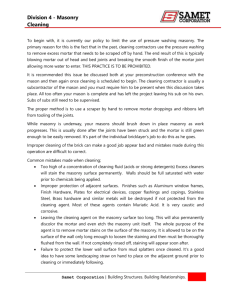MORTAR AND GROUT
advertisement
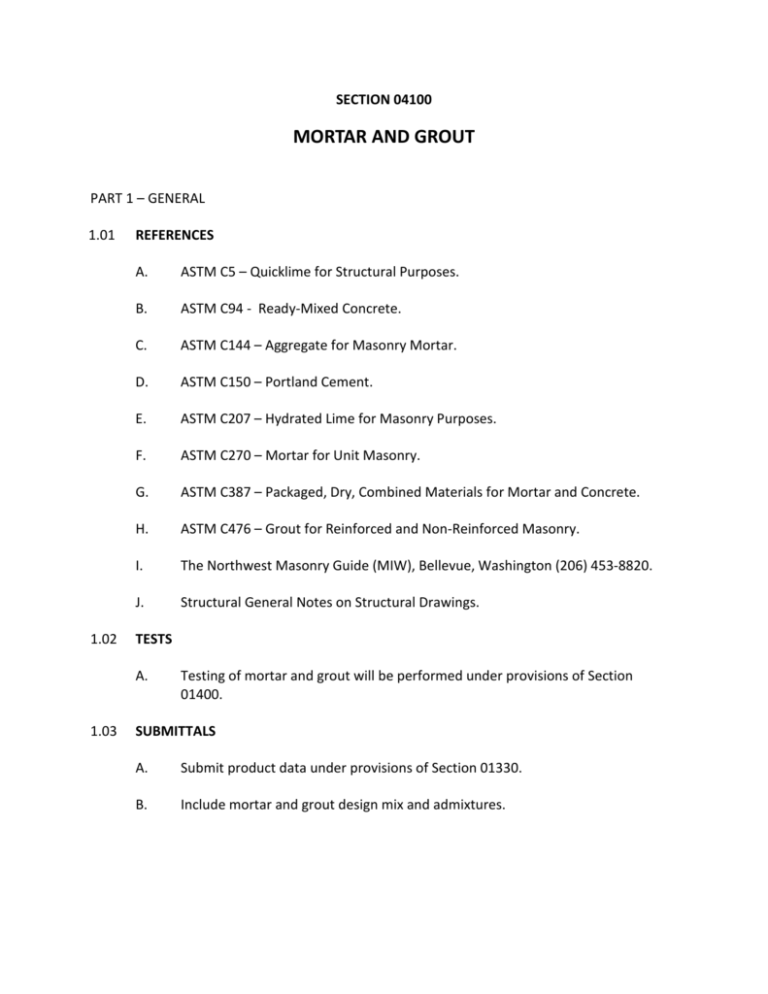
SECTION 04100 MORTAR AND GROUT PART 1 – GENERAL 1.01 1.02 REFERENCES A. ASTM C5 – Quicklime for Structural Purposes. B. ASTM C94 - Ready-Mixed Concrete. C. ASTM C144 – Aggregate for Masonry Mortar. D. ASTM C150 – Portland Cement. E. ASTM C207 – Hydrated Lime for Masonry Purposes. F. ASTM C270 – Mortar for Unit Masonry. G. ASTM C387 – Packaged, Dry, Combined Materials for Mortar and Concrete. H. ASTM C476 – Grout for Reinforced and Non-Reinforced Masonry. I. The Northwest Masonry Guide (MIW), Bellevue, Washington (206) 453-8820. J. Structural General Notes on Structural Drawings. TESTS A. 1.03 Testing of mortar and grout will be performed under provisions of Section 01400. SUBMITTALS A. Submit product data under provisions of Section 01330. B. Include mortar and grout design mix and admixtures. 1.04 ENVIRONMENTAL REQUIREMENTS A. 1.05 ALTERNATES A. 1.06 See Section 01230 for bidding alternates affecting Work of this Section. COLORS A. 1.07 Conform to recommendations of MIW – Northwest Masonry Guide for Masonry Construction during cold, hot, or wet weather. Colors are specified in Colors/Materials Schedule on drawings. SUSTAINABLE BUILDING REQUIREMENTS A. See Section 01011 for sustainable building requirements affecting the Work of this Section. PART 2 – PRODUCTS 2.01 MORTAR AND GROUT MIXES A. General 1. Refer to Structural General Notes on Structural Drawings. 2. Do not add admixtures, including color pigments, air-entraining agents, accelerators, retarders, water repellant agents, anti-freeze compounds, or other admixtures unless otherwise indicated. 3. Do not use calcium chloride in mortar or grout. B. Mortar for Unit Masonry: Comply with ASTM C270, type S. C. Grout for Unit Masonry: Comply with ASTM C476 for grout for use in construction of reinforced and non-reinforced unit masonry. D. Mortar for Glass Block: Type S in accordance with ASTM C270; with clean, white quartzite-type sand free of iron compounds, in accordance with ASTM C144, no less than 100% passing No. 16 sieve. Provide integral waterproofer, Sonneborn Hydrocide powder. Mortar shall conform to glass block manufacturer’s recommendations. E. Mixing: Combine and thoroughly mix cement, water, and aggregates in a mechanical batch mixer; comply with referenced ASTM standards for mixing time and water content. PART 3 – EXECUTION 3.01 INSTALLATION A. Mortar and grout installation is specified in Section 04240. B. Work grout into cores and cavities to eliminate voids. C. Do not displace reinforcing steel or anchors when placing grout. D. Clean concrete grout spaces of excess mortar and debris. END OF SECTION SECTION 04150 MASONRY ACCESSORIES PART 1 – GENERAL 1.01 ANCHORS A. Anchors shall be provided for securing finish masonry and back-up masonry. Corrugated anchors shall not be used. B. Anchors required to secure masonry to concrete shall be dovetail type. C. Anchors are required for tying interior partitions to existing structure and at all corners or intersections of partitions. D. Provide wire reinforcing in masonry joints. E. Sufficient expansion joints shall be provided for masonry work. END OF SECTION SECTION 04240 BRICK VENEER PART 1 – GENERAL 1.01 1.02 1.03 1.04 MOCK-UP A. Provide mock-up under provisions of Section 01400. B. Construct face brick to 3 x 4 ft. panel size, including mortar and accessories specified. C. Obtain approval prior to proceeding with the work. D. Remove the panel when directed by the Architect. The approved panel may be incorporated into the work at the discretion of the Architect. SUBMITTALS A. Submit anchoring system or approval. See structural notes. B. Submit brick samples for color approval. CERTIFICATES A. Submit manufacturer’s certificates under provisions of Section 01400. B. Submit manufacturer’s certificate that materials meet or exceed specified requirements. ENVIRONMENTAL REQUIREMENTS A. 1.05 Conform to Masonry Institute of Washington, Northwest Masonry Guide recommendations for cold, hot, and wet weather construction. ALTERNATES A. See Section 01230 for bidding alternates affecting Work in this Section. 1.06 COLORS A. 1.07 Coordinate color with Colors and Materials Schedule on drawings. SUSTAINABLE BUILDING REQUIREMENTS A. See Section 01011 for sustainable building requirements affecting the Work for this Section. PART 2 – PRODUCTS 2.01 2.02 MANUFACTURERS A. Mutual Materials B. H.C. Muddox C. Interstate Brick D. Substitutions: Under provisions of Section 01600. BRICK A. Size: Nominal 4 “x 3”x 8”, actual 3-1/2 “x 2-1/2”x 7-1/2”. B. Type: ASTM C216 and as follows: 1. C. 2.03 Color: Colors are specified in Colors/Materials Schedule. REINFORCEMENT AND ANCHORAGE A. 2.04 Grade SW, Type FBS. See Structural Notes. MASONRY FLASHING MATERIALS A. Metal Flashing: Fabricate from the following metal complying with requirements specified in Division 7 Section “Sheet Metal Flashing and Trim” and below: 1. Stainless steel: 0.0156 inch thick (dead soft temper) B. 2. Fabricate metal flashing terminations from sheet metal indicated above, formed to shape indicated. 3. Fabricate metal flashing terminations from sheet metal indicated above. Extend at least 3 inches into wall and out of exterior face of wall. At exterior face of wall, bend metal back on itself for ¾ inch and then down into joint 3/8 inch to form stop for retaining sealant backer rod. Contractor’s Option for Concealed Flashing: For flashing partly exposed to the exterior, use metal flashing specified above. For flashing not exposed to the exterior, use one of the following, unless otherwise indicated: 1. Rubberize-Asphalt Flashing: Manufacturer’s standard composite flashing product consisting of a pliable and highly adhesive rubberized-asphalt compound, bonded to a high-density, cross-laminated polyethylene interpolymner alloy 0.025 inch thick with a 0.015 inch thick layer of rubberized-asphalt adhesive. a. Provide flashing as a complete system with performed corners, end dams, other special shapes, and seaming materials; all produced by flashing sheet manufacturer. C. Solder and Sealants for Sheet Metal Flashings: As specified in Division 7 Section “Sheet Metal Flashing and Trim.” D. Adhesives, Primers, and Seam Tapes for Flashings: Flashings manufacturer’s standard products or products recommended by the flashing manufacturer for bonding flashing sheets to each other and substrates. E. Products: Subject to compliance with requirements, provide one of the following: 1. 2. Rubberized-Asphalt Flashing: a. Dur-O-Barrier, Dur-O-Wal, Inc. b. Perm-O-Barrier Wall Flashing: W.R. Grace & Co., Construction Products Division. c. Textroflash; Hohmann & Barnard, Inc. Elastromeric Thermoplastic Flashing: a. Hyload Flashing Membrane; Hyload Cloaked Flashing System. 2.05 2.06 MASONRY CLEANER AND WATER REPELLANT A. Cleaner: Type “V” as manufactured by Fabrikem or Sure-Klean “Vana Trol” as manufactured by ProSOCo, Inc. B. Water Repellant: Sure-Klean Weather Seal as manufactured by ProSoCo, Inc. or Fabrishield 761 as manufactured by Fabrikem. ACCESSORIES A. Cavity Drainage Material: Free-draining mesh; made from polyethylene strands and shaped to avoid being clogged by mortar droppings. 1. Products: Subject to compliance with requirements, provide one of the following: a. Mortar Break; Advanced Building Products, Inc. b. CavClear Masonry mat; CavClear. c. Mortar Net; Mortar Net USA, Ltd. d. Mortar Stop; Polytite Manufacturing Corp. PART 3 – EXECUTION 3.01 PREPARATION A. Supply veneer anchorage attachment per Structural Notes on drawings. B. Verify items provided by other Sections of work are properly sized and located. C. Establish lines, levels, and coursing. Protect from disturbance. D. Provide temporary bracing during erection of masonry work. Maintain in place until building structure provides permanent bracing. 3.02 3.03 3.04 3.05 COURSING A. Place masonry to lines and levels indicated. B. Maintain masonry courses to uniform width. Make vertical and horizontal joints equal and of uniform thickness. C. Lay brick in running bond. Form concave mortar joints. PLACING AND BONDING A. Lay masonry in full bed or mortar, properly jointed with other work. Buttering corners of joints and deep excessive furrowing of mortar joints are not permitted. B. Fully bond intersections and external and internal corners. C. Do not shift or tap masonry units after mortar has taken initial set. Where adjustment must be made, remove mortar and replace. D. Remove excess mortar. E. Perform job site cutting with proper tools to provide straight, unchipped edges. Take care to prevent breaking masonry unit corners or edges. F. Miter all corners of solider courses. CAVITY SPACE A. Do not mortar fall into cavity air space or plug weep holes; clean out promptly. B. Install 3/8” wide weep slots (full height of brick) in veneer at 24 inch on center staggered horizontally above through-wall flashings. TOLERANCES A. Variation from Unit to Adjacent Unit: 1/32 inch maximum. B. Variation from Plane of Wall: ¼ inch in 10 ft; ½ inch in 20 ft or more. C. Variation from Plumb: ¼ inch per story non-cumulative. D. Variation from Level Coursing: 1/8 inch in 3 ft; ¼ inch in 10 ft. E. 3.06 3.07 REINFORCEMENT AND ANCHORAGES A. See Structural Notes. B. Secure wall ties in accordance with Structural Notes. MASONRY FLASHINGS A. General: Install embedded flashing in masonry at shelf angles, lintels, ledges, other obstructions to downward flow of water in wall, and where indicated. B. Prepare masonry surfaces so they are smooth and free form projections that could puncture flashing. Unless otherwise indicated, place through-wall flashing on sloping bed of mortar and cover with mortar. Before covering with mortar, seal penetrations in flashing with adhesive, sealant, or tape as recommended by flashing manufacturer. C. Install flashing as follows: D. 3.08 Variation of Joint Thickness: 1/8 inch in 3 ft. 1. At masonry-veneer walls, extend flashing from exterior face of veneer, through veneer up face of sheathing at least 8 inches, and behind airinfiltration barrier or building paper. 2. At lintels and shelf angles, extend flashing a minimum of 4 inches into masonry at each end. At heads and sills, extend flashing 4 inches at ends and turn flashing up not less than 2 inches to form a pan. Install reglets and nailers for flashing and other related construction where they are shown to be built into masonry. BUILT-IN WORK A. As work progresses, build-in metal doorframes, fabricated metal frames, window frames, wood nailing strips, anchor bolts, plates, and other items to be built in work supplied by other Sections. B. Build-in items plumb and level. C. Do not build-in organic materials subject to deterioration. 3.09 CUTTING AND FITTING A. B. 3.10 3.11 3.12 Cut and fit for chases, pipes, conduit, sleeves, and grounds. Coordinate with other Sections of work to provide correct size, shape and location. Obtain approval prior to cutting or fitting any area not indicated or where appearance or strength of masonry work may be impaired. MASONRY CLEANER AND WATER REPELLENT A. Clean and apply water repellent to exposed brick, concrete, and parge-coated walls. B. Cleaner: Dilute and apply heavy-duty cleaner in accordance with manufacturer’s instruction. C. Water Repellent: Apply in accordance with manufacturer’s instructions. Do not dilute. Apply with low-pressure (20 psi) airless spray equipment or with saturated brush or roller. Apply in a flooding application, from the bottom up with sufficient material applied to produce a 6 inch to 8 inch rundown below the contact point of spray pattern with the masonry or concrete surface. Allow the first application to penetrate the surface (approximately 3 to 5 minutes) and reapply in the same saturating manner. PROTECTION A. Protect finished installation. B. Maintain protective boards at exposed external corners that may be damaged by construction activities. C. Provide protection without damaging completed work. D. At day’s end, cover unfinished walls to prevent moisture infiltration. REPAIRING, POINTING, AND CLEANING A. Remove and replace masonry units that are loose, chipped, broken, stained, or otherwise damaged or that do not match adjoining units. Install new units to match adjoining units; install in fresh mortar, pointed to eliminate evidence of replacement. B. Pointing: During the tooling of joints, enlarge voids and holes, except weep holes, and completely fill with mortar. Point up joints, including corners, openings, and adjacent construction, to provide a neat, uniform appearance. Prepare joints for sealant application. C. In-Progress Cleaning: Clean unit masonry as work progresses by dry brushing to remove mortar fins and smears before tooling joints. D. Final Cleaning: After mortar is thoroughly set and cured, clean exposed masonry as follows: 1. Remove large mortar particles by hand with wooden paddles and nonmetallic scrape hoes and chisels. 2. Test cleaning methods on sample wall panel; leave one-half of panel uncleaned for comparison purposes. Obtain Architect’s approval of sample cleaning before proceeding with cleaning of masonry. 3. Protect adjacent stone and non-masonry surfaces from contact with cleaner by covering them with liquid strippable masking agent, polyethylene film, or waterproof masking tape. 4. Wet wall surfaces with water before applying cleaners; remove cleaners promptly by rinsing the surfaces thoroughly with clear water. 5. Clean brick by the bucket-and-brush hand washing method described in BIA Technical Notes No. 20, using job-mixed detergent solution. 6. Clean masonry with a proprietary acidic cleaner applied according to manufacturer’s written instructions. 7. Clean concrete masonry by cleaning method indicated in NCMA Tek 8-2 applicable to type of stain on exposed surfaces. END OF SECTION
